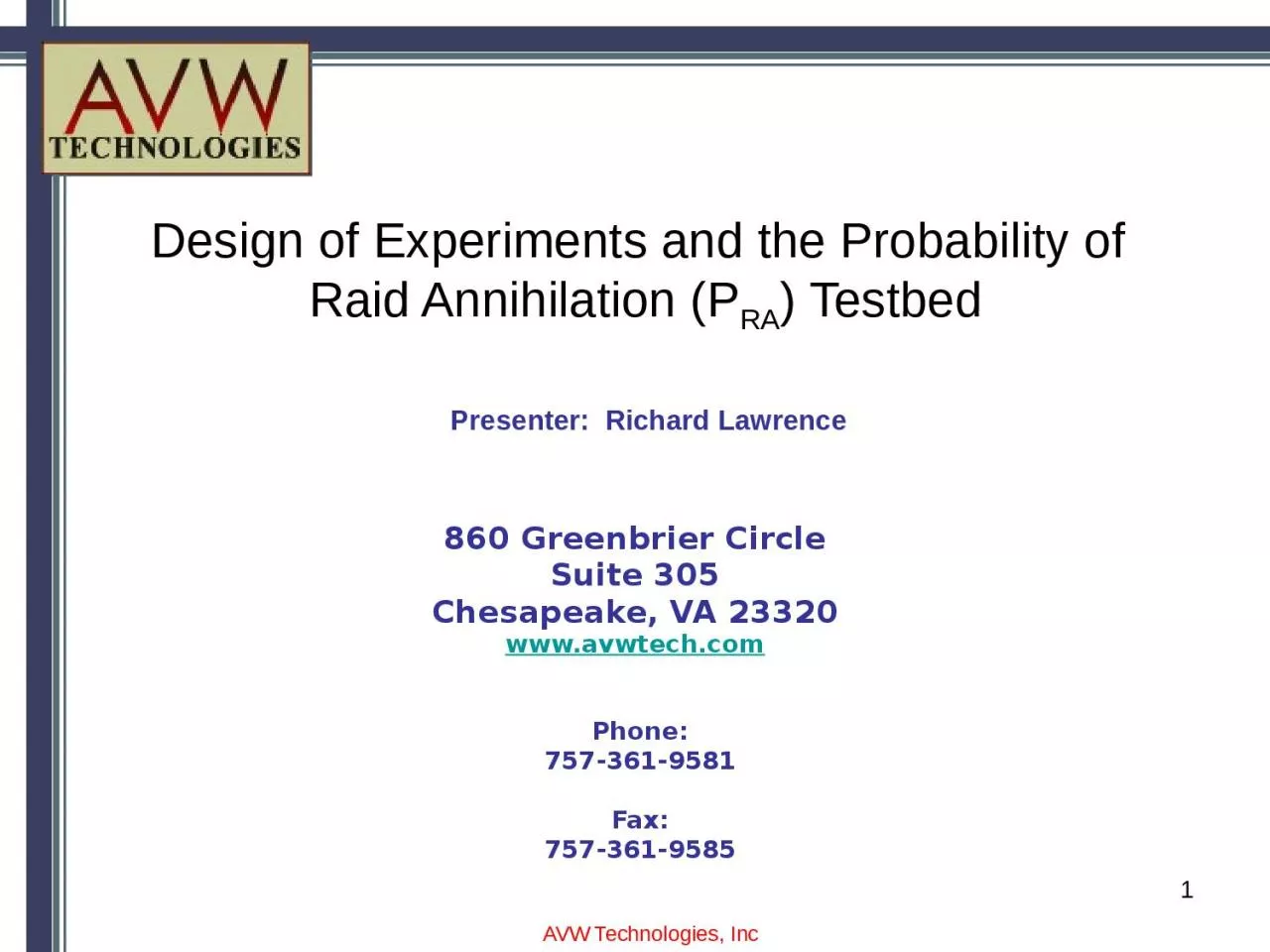

Raid Annihilation P RA Testbed 860 Greenbrier Circle Suite 305 Chesapeake VA 23320 wwwavwtechcom Phone 7573619581 Fax 7573619585 Presenter Richard Lawrence AVW Technologies Inc ID: 1045731
Download Presentation The PPT/PDF document "Design of Experiments and the Probabilit..." is the property of its rightful owner. Permission is granted to download and print the materials on this web site for personal, non-commercial use only, and to display it on your personal computer provided you do not modify the materials and that you retain all copyright notices contained in the materials. By downloading content from our website, you accept the terms of this agreement.
1. Design of Experiments and the Probability of Raid Annihilation (PRA) Testbed860 Greenbrier CircleSuite 305Chesapeake, VA 23320www.avwtech.comPhone:757-361-9581Fax:757-361-9585Presenter: Richard Lawrence AVW Technologies, Inc1
2. IntroductionDesign of Experiments (DOE) offers the opportunity for efficiency in test execution and to gain insight to the operations of complex systems. The current AAW SSD PRA metric is not DOE friendly in that the outputs of the Testbed do not lend themselves to straightforward statistical analysis. This is an overview of the challenges to executing a serious DOE process on the PRA Testbed and proposed methods to solve these challenges.Design of Experiments and PRA TestbedPresentation Outline Usable definition of DOE Background Challenges Levels of Factors Scoring Non-Determinism Basic Steps ConclusionAVW Technologies, Inc2
3. Create a statistical model of a system based on identified factors and measured outputs. Purposefully vary input (factors) and correlate with outputs.Principles of DOEAVW Technologies, Inc3PROCESSX1X2X3X4InputsOutputsY1Y2
4. Run matrix is developed from several techniques to establish a ‘sample space’. Different from ‘One Factor at a Time’ testing because variables are changed several at a time and effects are separated in the analysis phase. Through analysis of outputs, identifies and quantifies effects of various factorsPrinciples of DOE (2)AVW Technologies, Inc4RunX1X2X3X4Y1Y2YaveσY1+0052-++23-0+2n
5. Current PRA methodology is:Operationally relevantAccepted and EstablishedOriented solely to calculate a single value (PRA)Ideal candidate for in-depth DOEBackground“Clean”and“Dirty”SignaturesLittoral ScenarioScenarioT1R1 - sea-skimming, subsonic RF threatT2 - sea-skimming, subsonic Imaging IR threatT5 - high diver, supersonic RF ARM threatT7 - sea-skimming, maneuvering supersonic Advanced RF ThreatAVW Technologies, Inc5
6. Background and ChallengesAVW Technologies, Inc6 Run Reduction Strategy for LPD 17 based on rudimentary application of DOE. Historical analysis was attempted for LPD 17 data by AVW and DOT&E. No surprising insights resulted Lessons learned:Categorized variables like radial are difficult to analyze, since they are not continuous.Binary outcomes are even more difficult to analyze because there is no conventional way to calculate variance & other statistical parameters. Necessitates a more in-depth approach to find confounding factors and their interrelationships.
7. Difficult to identify ‘specific factors’ in particular scenariosRequires runs to investigate Each scenario (radial, TOD, etc.) has a confluence of factors Example--different radials vary the following: RF propagation for ship sensors (duct strength, height) RF clutter for ship radars (land, wave direction) Ship radar blockage RF propagation for threat seeker Ship RCS/Decoy effectiveness IR scene for RAM Wind Threat spacing in bearing and distanceAdditional ChallengesAVW Technologies, Inc7
8. Empirical way to quantify input factors Each radial would include a parameter for RF prop, clutter, IR scene, RCS, threat separation Categorize each parameter: +1 favorable conditions 0 neutral conditions -1 adverse conditionsExample: Environment CategorizationAVW Technologies, Inc8Ultimate goal is to eliminate test cases.
9. Analytical way to quantify outcomes Miss distance Aimpoint errors Scoring related to ship (vulnerability)ScoringAVW Technologies, Inc9
10. Non-Determinism Demonstrated differing outcomes given identical scenarios during DT5. Attributable to the way tactical software operates. Is there a minimum number of trials required to give a statistically significant outcome?Would require a large number of runs for each scenarioOR Treat each scenario as we do in real ships—any given event can go many different waysAVW Technologies, Inc10
11. Basic Steps Identify factors Establish types and levels for each factor Assign factor levels to each scenario Identify, execute and analyze screening runs Develop formalized run matrix Execute runs Analyze results Refine formalized run matrixbased on identified relevantfactorsAVW Technologies, Inc11
12. Bottom Lines DOE is a natural complement to ongoing V&V process Gain value from Testbed runs during DTs (maximizing resource investment) Analytical insight into Combat Systems performance and factors influencing engagement outcomes Defendable approach to Testbed runs—to complement COTF’s methodologyAVW Technologies, Inc12
13. Design of Experiments and the Probability of Raid Annihilation (PRA) Testbed860 Greenbrier CircleSuite 305Chesapeake, VA 23320www.avwtech.comPhone:757-361-9581Fax:757-361-9585AVW Technologies, Inc13